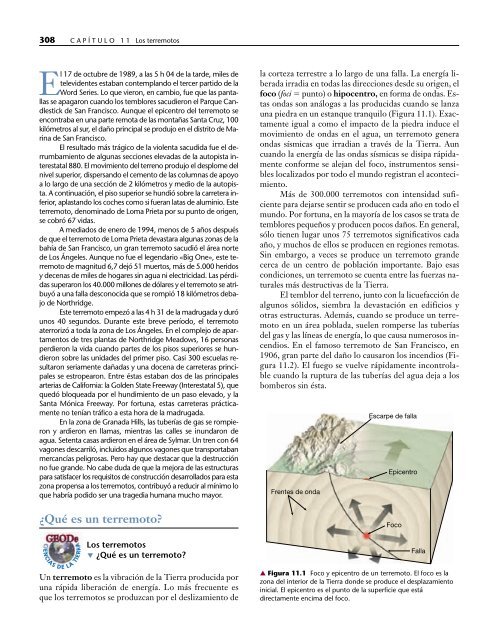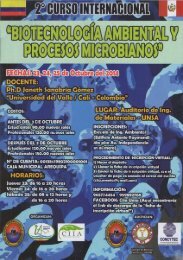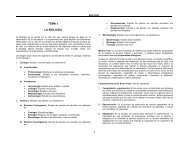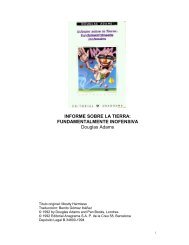Create successful ePaper yourself
Turn your PDF publications into a flip-book with our unique Google optimized e-Paper software.
308 CAPÍTULO 11 Los terremotos<br />
El 17 <strong>de</strong> octubre <strong>de</strong> 1989, a <strong>la</strong>s 5 h 04 <strong>de</strong> <strong>la</strong> tar<strong>de</strong>, miles <strong>de</strong><br />
televi<strong>de</strong>ntes estaban contemp<strong>la</strong>ndo el tercer partido <strong>de</strong> <strong>la</strong><br />
Word Series. Lo que vieron, en cambio, fue que <strong>la</strong>s pantal<strong>la</strong>s<br />
se apagaron cuando los temblores sacudieron el Parque Candlestick<br />
<strong>de</strong> San Francisco. Aunque el epicentro <strong>de</strong>l terremoto se<br />
encontraba en una parte remota <strong>de</strong> <strong>la</strong>s montañas Santa Cruz, 100<br />
kilómetros al sur, el daño principal se produjo en el distrito <strong>de</strong> Marina<br />
<strong>de</strong> San Francisco.<br />
El resultado más trágico <strong>de</strong> <strong>la</strong> violenta sacudida fue el <strong>de</strong>rrumbamiento<br />
<strong>de</strong> algunas secciones elevadas <strong>de</strong> <strong>la</strong> autopista interestatal<br />
880. El movimiento <strong>de</strong>l terreno produjo el <strong>de</strong>splome <strong>de</strong>l<br />
nivel superior, dispersando el cemento <strong>de</strong> <strong>la</strong>s columnas <strong>de</strong> apoyo<br />
a lo <strong>la</strong>rgo <strong>de</strong> una sección <strong>de</strong> 2 kilómetros y medio <strong>de</strong> <strong>la</strong> autopista.<br />
A continuación, el piso superior se hundió sobre <strong>la</strong> carretera inferior,<br />
ap<strong>la</strong>stando los coches como si fueran <strong>la</strong>tas <strong>de</strong> aluminio. Este<br />
terremoto, <strong>de</strong>nominado <strong>de</strong> Loma Prieta por su punto <strong>de</strong> origen,<br />
se cobró 67 vidas.<br />
A mediados <strong>de</strong> enero <strong>de</strong> 1994, menos <strong>de</strong> 5 años <strong>de</strong>spués<br />
<strong>de</strong> que el terremoto <strong>de</strong> Loma Prieta <strong>de</strong>vastara algunas zonas <strong>de</strong> <strong>la</strong><br />
bahía <strong>de</strong> San Francisco, un gran terremoto sacudió el área norte<br />
<strong>de</strong> Los Ángeles. Aunque no fue el legendario «Big One», este terremoto<br />
<strong>de</strong> magnitud 6,7 <strong>de</strong>jó 51 muertos, más <strong>de</strong> 5.000 heridos<br />
y <strong>de</strong>cenas <strong>de</strong> miles <strong>de</strong> hogares sin agua ni electricidad. Las pérdidas<br />
superaron los 40.000 millones <strong>de</strong> dó<strong>la</strong>res y el terremoto se atribuyó<br />
a una fal<strong>la</strong> <strong>de</strong>sconocida que se rompió 18 kilómetros <strong>de</strong>bajo<br />
<strong>de</strong> Northridge.<br />
Este terremoto empezó a <strong>la</strong>s 4 h 31 <strong>de</strong> <strong>la</strong> madrugada y duró<br />
unos 40 segundos. Durante este breve período, el terremoto<br />
aterrorizó a toda <strong>la</strong> zona <strong>de</strong> Los Ángeles. En el complejo <strong>de</strong> apartamentos<br />
<strong>de</strong> tres p<strong>la</strong>ntas <strong>de</strong> Northridge Meadows, 16 personas<br />
perdieron <strong>la</strong> vida cuando partes <strong>de</strong> los pisos superiores se hundieron<br />
sobre <strong>la</strong>s unida<strong>de</strong>s <strong>de</strong>l primer piso. Casi 300 escue<strong>la</strong>s resultaron<br />
seriamente dañadas y una docena <strong>de</strong> carreteras principales<br />
se estropearon. Entre éstas estaban dos <strong>de</strong> <strong>la</strong>s principales<br />
arterias <strong>de</strong> California: <strong>la</strong> Gol<strong>de</strong>n State Freeway (Interestatal 5), que<br />
quedó bloqueada por el hundimiento <strong>de</strong> un paso elevado, y <strong>la</strong><br />
Santa Mónica Freeway. Por fortuna, estas carreteras prácticamente<br />
no tenían tráfico a esta hora <strong>de</strong> <strong>la</strong> madrugada.<br />
En <strong>la</strong> zona <strong>de</strong> Granada Hills, <strong>la</strong>s tuberías <strong>de</strong> gas se rompieron<br />
y ardieron en l<strong>la</strong>mas, mientras <strong>la</strong>s calles se inundaron <strong>de</strong><br />
agua. Setenta casas ardieron en el área <strong>de</strong> Sylmar. Un tren con 64<br />
vagones <strong>de</strong>scarriló, incluidos algunos vagones que transportaban<br />
mercancías peligrosas. Pero hay que <strong>de</strong>stacar que <strong>la</strong> <strong>de</strong>strucción<br />
no fue gran<strong>de</strong>. No cabe duda <strong>de</strong> que <strong>la</strong> mejora <strong>de</strong> <strong>la</strong>s estructuras<br />
para satisfacer los requisitos <strong>de</strong> construcción <strong>de</strong>sarrol<strong>la</strong>dos para esta<br />
zona propensa a los terremotos, contribuyó a reducir al mínimo lo<br />
que habría podido ser una tragedia humana mucho mayor.<br />
¿Qué es un terremoto?<br />
IE N CIA S<br />
D E<br />
TIER R<br />
L A<br />
Los terremotos<br />
¿Qué es un terremoto?<br />
▲<br />
Un terremoto es <strong>la</strong> vibración <strong>de</strong> <strong>la</strong> <strong>Tierra</strong> producida por<br />
una rápida liberación <strong>de</strong> energía. Lo más frecuente es<br />
que los terremotos se produzcan por el <strong>de</strong>slizamiento <strong>de</strong><br />
<strong>la</strong> corteza terrestre a lo <strong>la</strong>rgo <strong>de</strong> una fal<strong>la</strong>. La energía liberada<br />
irradia en todas <strong>la</strong>s direcciones <strong>de</strong>s<strong>de</strong> su origen, el<br />
foco (foci punto) o hipocentro, en forma <strong>de</strong> ondas. Estas<br />
ondas son análogas a <strong>la</strong>s producidas cuando se <strong>la</strong>nza<br />
una piedra en un estanque tranquilo (Figura 11.1). Exactamente<br />
igual a como el impacto <strong>de</strong> <strong>la</strong> piedra induce el<br />
movimiento <strong>de</strong> ondas en el agua, un terremoto genera<br />
ondas sísmicas que irradian a través <strong>de</strong> <strong>la</strong> <strong>Tierra</strong>. Aun<br />
cuando <strong>la</strong> energía <strong>de</strong> <strong>la</strong>s ondas sísmicas se disipa rápidamente<br />
conforme se alejan <strong>de</strong>l foco, instrumentos sensibles<br />
localizados por todo el mundo registran el acontecimiento.<br />
Más <strong>de</strong> 300.000 terremotos con intensidad suficiente<br />
para <strong>de</strong>jarse sentir se producen cada año en todo el<br />
mundo. Por fortuna, en <strong>la</strong> mayoría <strong>de</strong> los casos se trata <strong>de</strong><br />
temblores pequeños y producen pocos daños. En general,<br />
sólo tienen lugar unos 75 terremotos significativos cada<br />
año, y muchos <strong>de</strong> ellos se producen en regiones remotas.<br />
Sin embargo, a veces se produce un terremoto gran<strong>de</strong><br />
cerca <strong>de</strong> un centro <strong>de</strong> pob<strong>la</strong>ción importante. Bajo esas<br />
condiciones, un terremoto se cuenta entre <strong>la</strong>s fuerzas naturales<br />
más <strong>de</strong>structivas <strong>de</strong> <strong>la</strong> <strong>Tierra</strong>.<br />
El temblor <strong>de</strong>l terreno, junto con <strong>la</strong> licuefacción <strong>de</strong><br />
algunos sólidos, siembra <strong>la</strong> <strong>de</strong>vastación en edificios y<br />
otras estructuras. A<strong>de</strong>más, cuando se produce un terremoto<br />
en un área pob<strong>la</strong>da, suelen romperse <strong>la</strong>s tuberías<br />
<strong>de</strong>l gas y <strong>la</strong>s líneas <strong>de</strong> energía, lo que causa numerosos incendios.<br />
En el famoso terremoto <strong>de</strong> San Francisco, en<br />
1906, gran parte <strong>de</strong>l daño lo causaron los incendios (Figura<br />
11.2). El fuego se vuelve rápidamente incontro<strong>la</strong>ble<br />
cuando <strong>la</strong> ruptura <strong>de</strong> <strong>la</strong>s tuberías <strong>de</strong>l agua <strong>de</strong>ja a los<br />
bomberos sin ésta.<br />
Frentes <strong>de</strong> onda<br />
Escarpe <strong>de</strong> fal<strong>la</strong><br />
Epicentro<br />
Foco<br />
Fal<strong>la</strong><br />
▲ Figura 11.1 Foco y epicentro <strong>de</strong> un terremoto. El foco es <strong>la</strong><br />
zona <strong>de</strong>l interior <strong>de</strong> <strong>la</strong> <strong>Tierra</strong> don<strong>de</strong> se produce el <strong>de</strong>sp<strong>la</strong>zamiento<br />
inicial. El epicentro es el punto <strong>de</strong> <strong>la</strong> superficie que está<br />
directamente encima <strong>de</strong>l foco.








